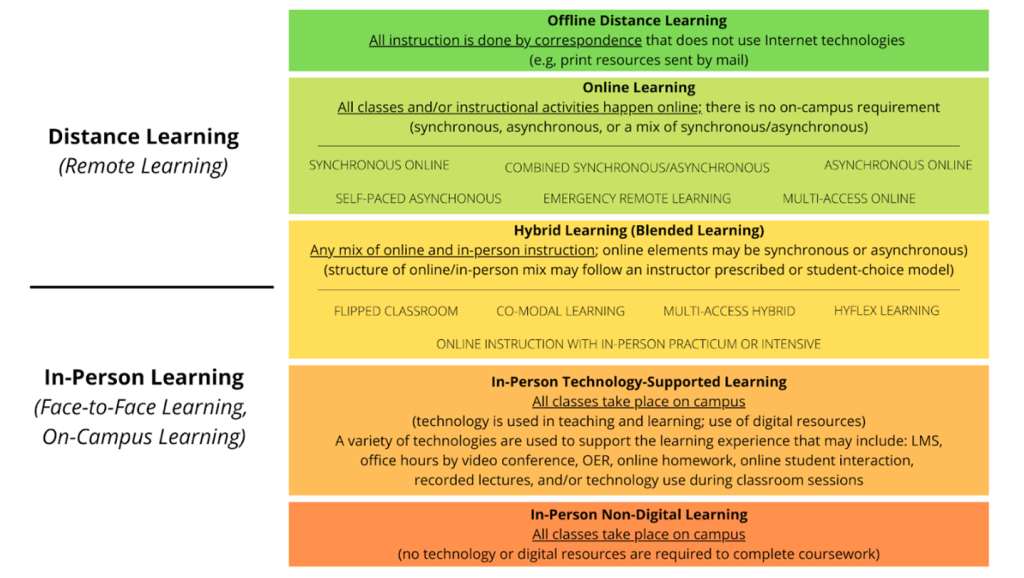What To Do When A Modality of A Learning Experience is Unclear? – New WCET Paper
Published by: WCET | 9/14/2023
Tags: Digital Learning, Distance Education, Managing Digital Learning, Online Learning
Published by: WCET | 9/14/2023
Tags: Digital Learning, Distance Education, Managing Digital Learning, Online Learning
WCET members spend countless hours in committee meetings trying to finesse definitions for digital learning modalities. Help is on the way!!! Nicole Johnson’s new WCET-sponsored paper addresses the basic question: “What to do when a modality of a learning experience is unclear?”
Nicole Johnson is the Executive Director of the Canadian Digital Learning Research Association (CDLRA). In the paper, she provides “guidelines for creating multidimensional learning experiences.” It should help when you need to answer questions about how to label a course, whether a new modality definition is needed, or what to do in the grey space in between those, and all the other related inquiries.
No guidelines are perfect. But, this will help.
Way back when, I had a small part in creating the CDLRA as Canada has no national counterpart to the U.S. Department of Education to collect data on distance education enrollments or most anything else. The CDLRA surveys have proven valuable in gauging progress and potholes in digital learning across the country and in some specific provinces. Not being a federal agency has also given it the freedom to ask much more interesting questions.
Not long after Nicole assumed her leadership role, someone told her to give me a call. As you can imagine, we joyfully geeked out on the nuances of digital learning data. We especially focused on the emerging mess of digital learning modality definitions. Those were murky and bad before the pandemic, and they are seemingly much worse now. It was a joy to talk to her and it is a joy to work with her.
Check out the CDLRA website to see the results of surveys they have performed on several different instructional technology issues in Canada.

The WCET Steering Committee set modality definitions as one of the top priorities for our staff focus over recent years. As a result, we have conducted research and created several resources for WCET Members and the higher education community at large. All of these are available on the WCET website:
It’s a quick read, so I don’t want to spoil it and Nicole is more eloquent than I am. She uses some different “cases” to illustrate broad, similar situations in addressing the difficulties and possible solutions when applying modality definitions. Some of the main points are highlighted below.
Nicole builds on a chart that she first created for the initial report resulting from the survey on agreement of digital learning definitions. It is now difficult to find courses that make NO USE of digital technologies.

Additionally, faculty have, rightfully, made countless choices on what technologies to use, when to meet in-person, and when to meet synchronously. The forced “emergency remote” migration accelerated this trend. The reason that it is difficult to classify modalities into discrete buckets is that the buckets are not discrete.
While the paper doesn’t go too deeply into this issue, it is a important problem. Kathryn Kerensky (State Authorization Network), Nicole, and I have mused over Zoom about some institutional definitions. One institution seems to completely violate the basic tenets of how one definition is used when compared to everywhere else in the world. We have also seen a few papers on another supposed modality, which confused us. If we do not know what they mean (and we asked Van Davis, too), pity the poor student who does not study the nuances of modalities for a living.
Please note that I chose not to implicate the guilty in this post, but you can ask me if you want.
We are doubling down on what we learned from the student focus groups. Students need to know what the academic experience will be like. Do they need to be somewhere in person? Do they need to meet at a time appointed virtually? What technology and software are needed and what does it cost?
Finally, we hope that you enjoy the paper.
We would love to hear your feedback on what worked for you, what did not work for you, and additional ideas for future research or papers on digital learning definitions.
Executive Director, WCET & Vice President for Technology-Enhanced Education, WICHE (retired)